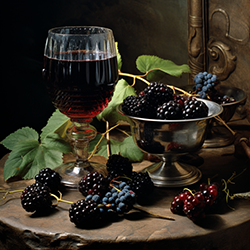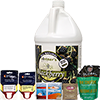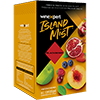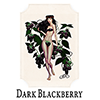The Art of Blackberry Wine: A Symphony of Science and Senses
Posted by Matteo Lahm on 17th Jul 2023
Hello, you budding Bacchus! Let's talk about crafting the perfect blackberry wine. It's a bit like conducting a symphony, where every note (or in this case, every berry) matters.
Before we get into the specs, let’s discuss the fruit itself if you will be working with fresh blackberries. Pulverize them as much as possible. You do not want any trapped juice because that will throw off your hydrometer and acid test readings, and you will need to do both. Your fruit can vary greatly in sweetness and acidity, and you need to know what you are dealing with before you commence with fermentation. You should also avoid cooking your fruit. It is not necessary or beneficial. Furthermore, making blackberry wine exclusively from fresh fruit can be cost prohibitive. You’ll only get about half the yield by weight to fresh grapes and they have a lot less sugar. You will likely have to cut your fruit with something and instead of just adding water, you have good options to choose from. Blending with blackberry puree or wine base is a great option. The purees are more expensive but more integral so depending on your budget, you can do what you can but, either option is better than water. It will improve your yield, maintain the flavor and allow you to add a lot less sugar and fruit acid before fermenting.
Plan to have acid blend on hand when you are preparing your must. You should also have simple syrup ready to go. Click here for preparation instructions. In either case, the components should be added when already dissolved. Granulated sugar is a bad habit you should break if you have it. It takes a long time to dissolve, and you will not get good readings. The same goes for acid blend. Dissolve your acid blend in distilled water first.

Now that your fruit is crushed and your tools and additives are ready, let's talk about Original Specific Gravity (OSG). Think of OSG as the maestro of your symphony, setting the tempo for the fermentation process. For blackberry wine, you want an OSG between 1.070 and 1.085. This will give your wine a robust body and a healthy alcohol content without overdoing it. Anything higher than a 12% ABV will be overpowering and maybe even undrinkable. Let’s face it, you are making wine, not jet fuel. Berry wine does not have the tannins or structure to support higher alcohol levels found in grape wines like Brunello or California Cabernets.
Now, onto pH. This is your orchestra's harmony, balancing the acidity and sweetness of your wine. Aim for a pH between 3.2 and 3.4. This will give your blackberry wine a crisp, refreshing taste that's not too tart, not too sweet, but just right. Keep in mind that the more you back sweeten, the more acidic your wine should be. Sweet needs to be balanced by tart. Also keep in mind that malic acid is dominant so if you are adding acid blend, you may want to use malic acid powder instead of generic acid blend as malic acid can constitute more than 80% of the acid profile.
As for your yeast, think of it as the first violinist in your orchestra, leading the fermentation process. Remember, the yeast makes the wine, not you. For blackberry wine, Lalvin 71B and V-1116 are great choices. These yeasts are best suited for sweet and semisweet wines and will produce a clean, fruity flavor that complements the blackberries beautifully. If you are working with fresh fruit, add ¼ tsp sulfites per 6-gallons of must and wait 18-24 hours to pitch your yeast. If you’ve never worked with sulfites, that waiting period before pitching your yeast is important because the sulfites lose strength and you don’t want them to negatively affect your cultured yeast.
Temperature is another key player in our symphony. It's like the acoustics of the concert hall, affecting how everything comes together. Aim for a fermentation temperature between 60 and 70 degrees Fahrenheit. This will ensure a smooth, steady fermentation that brings out the best in your blackberries. The difference within the range is like comparing a waltz and a tango.
At the cooler end of the spectrum, around 60 degrees Fahrenheit, the fermentation process slows down. This is the waltz of winemaking. It's a slower, more controlled dance that allows for a more nuanced development of flavors and aromas. The yeast has more time to interact with the sugars and other components in the blackberries, which can result in a wine with more complex, layered flavors and a more pronounced fruity aroma.
On the other hand, at the warmer end, around 70 degrees Fahrenheit, fermentation speeds up. This is the tango of winemaking. It's a passionate, fast-paced dance that can lead to a more robust, full-bodied wine. The yeast works faster, converting sugars into alcohol at a quicker rate. This can result in a wine with a bolder, more intense flavor. However, the faster fermentation can also mean less time for the development of subtle flavors and aromas.
So, whether you prefer the slow waltz of cooler fermentation or the fiery tango of warmer fermentation, remember that both dances can produce a beautiful bottle of blackberry wine. It's all about finding the rhythm that suits your taste. Either way, keep it in that range. If you go below 60, you will get stuck fermentation because you will be below the temperature threshold of the yeast. If you go above 70, a whole other dynamic unfolds.
If you were to let your temperature get close to 80 degrees Fahrenheit, it would be like cranking up the volume at a rock concert. It might seem like a good idea at first, but it can quickly lead to a cacophony of flavors that are out of balance. At higher temperatures, yeast activity increases, leading to a faster fermentation process. While this might sound like a time-saver, it can actually have several negative effects on your wine.
Firstly, the rapid fermentation can lead to the production of unwanted byproducts, such as higher alcohols and volatile acidity. These can give your wine off-flavors and aromas, often described as 'hot' or 'burnt', and can make the wine taste unbalanced or harsh. Secondly, the increased yeast activity can result in the loss of delicate flavors and aromas. The subtle nuances of the blackberries might be overpowered by the strong, harsh flavors produced by the yeast.
Now let's discuss back sweetening. This is like the encore of your symphony, adding a final touch of sweetness to your wine. For blackberry wine, sweeten to taste but it is important to proceed with caution. Start with a small amount, taste, and add more if needed. A good practice is to be reserved and patient. It takes time for the sugars to evenly dissolve. If you sweeten to taste on your first run, you may be disappointed when you try it a week later. It will be sweeter so sweeten almost to taste and then leave it in the carboy. Then come back to it and taste it again after a few days. Remember, you can always add more sweetness, but you can't take it away! Once it passes your taste test, you can proceed with bottling.
So, assuming you do everything right and your wine is made, let's talk about aging. Like a fine symphony, a good wine needs time to develop and mature. For blackberry wine, it is recommended to age it for at least one year. This will allow the flavors to meld together and the harsh tannins to mellow out, resulting in a smoother, more refined taste.
Before wrapping up, let’s just touch on one more point that may apply to you. If you have never done any of this and would like to get your feet wet with kits, you have options.
The Vintner’s Best Blackberry Fruit Base Kit is the least expensive and most generic option.
Then there is the Winexpert Island Mist Blackberry Wine Kit which is more expensive but a step up in quality.
At the top end is the Finer Wine Kits Dark Blackberry Frutta Wine Kit. This is the Cadillac of blackberry wine kits and has the highest ABV.
Regardless of which you might choose, all of these kits are formulated with the right acidity and sugars so there is no guess work. Just follow the instructions.
In conclusion, crafting the perfect blackberry wine is a journey of discovery, a dance between science and art. It's about understanding the nuances of your ingredients, the subtleties of your tools, and the rhythm of your processes. It's about finding the perfect balance between sweetness and acidity, body and flavor, patience and passion. But most importantly, it's about creating something that is uniquely yours. So, as you embark on this winemaking adventure, remember to trust your instincts, embrace the process, and above all, enjoy the symphony of senses that is blackberry wine. After all, you're not just making wine, you're creating a masterpiece. Now, go forth, budding Bacchus, and let the world taste your symphony!




